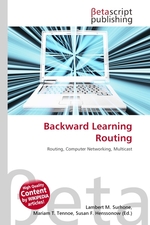Backward Learning Routing
Lambert M. Surhone, Mariam T. Tennoe, Susan F. Henssonow
бумажная книга
High Quality Content by WIKIPEDIA articles! Backward learning routing is a routing strategy for networks where the network nodes acquire knowledge of the network state as packets are handled. The routing is originally random. A packet with a hopcount of one is from a directly connected node. Thus, neighboring nodes are identified with their connecting links. A packet with a hop count of two is from a source two hops away, etc. As packets arrive, the IMP compares the hop count for a given source address with the minimum hop count already registered; if the new one is less, it is substituted for the previous one. In order to be able to adapt to deterioration of routes (e.g. link failures), the acquired information has to be "forgotten" periodically.
Данное издание не является оригинальным. Книга печатается по технологии принт-он-деманд после получения заказа.


